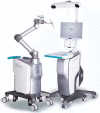Guidance for the Treatment of Femoral Neck Fracture with Precise Minimally Invasive Internal Fixation Based on the Orthopaedic Surgery Robot Positioning System
- PMID: 31062519
- PMCID: PMC6595117
- DOI: 10.1111/os.12451
Guidance for the Treatment of Femoral Neck Fracture with Precise Minimally Invasive Internal Fixation Based on the Orthopaedic Surgery Robot Positioning System
Abstract
Femoral neck fractures are among the most common fractures in orthopaedics. There are many surgical methods for the treatment of femoral neck fracture. Percutaneous cannulated lag screw fixation for the treatment of femoral neck fractures is favored by orthopaedic doctors because of its characteristics of being minimally invasive, with less bleeding and firm fixation. However, traditional freehand screw placement is limited by many factors, and the screw malposition rate is very high, which directly leads to the reduction of its biomechanical stability, and even leads to the ischemic necrosis of the femoral head caused by damage to blood vessels. In addition, excessive attempts to drill holes can damage cancellous bone and affect the screw's holding force, which reduces the stability of internal fixation and increases the risk of failure. At the same time, too much radiation exposure to medical personnel and patients also causes great damage to the body. Robot-assisted orthopaedic surgery combines the mechanical "eye" (an infrared ray tracking device) and the mechanical "hand" (six degrees of freedom mechanical arm), and through the process of preoperative planning, intraoperative assistance in screw placement, and postoperative confirmation, provides a more minimally invasive and precise treatment method for this kind of surgery, and significantly reduces radiation exposure. This guide uses the TiRobot system as an example to describe the robot surgery in detail, aiming at standardizing the application of robots in orthopaedic surgery.
Keywords: Femoral neck fracture; Internal fixation; Precise minimally treatment.
© 2019 The Authors. Orthopaedic Surgery published by Chinese Orthopaedic Association and John Wiley & Sons Australia, Ltd.
Figures






References
-
- Gümüştaş SA, Tosun HB, Ağır İ, Orak MM, Onay T, Okçu G. Influence of number and orientation of screws on stability in the internal fixation of unstable femoral neck fractures. Acta Orthop Traumatol Turc, 2014, 48: 673–678. - PubMed
-
- Filipov O. The method of biplane double‐supported screw fixation (BDSF) at femoral neck fracture – principle and clinic outcomes. Journal of Imab Annual Proceeding, 2013, 19: 423–428.
-
- Mei J, Liu S, Jia G, Cui X, Jiang C, Ou Y. Finite element analysis of the effect ofcannulated screw placement and drilling frequency on femoral neck fracture fixation. Injury, 2014, 45: 2045–2050. - PubMed
-
- Li J, Wu T, Xu Z, Gu X. A pilot study of post‐total knee replacement gait rehabilitation using lower limbs robot‐assisted training system. Eur J Orthop Surg Traumatol, 2014, 24: 203–208. - PubMed
MeSH terms
Grants and funding
LinkOut - more resources
Full Text Sources
Medical

